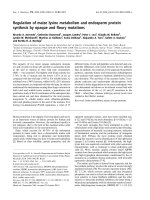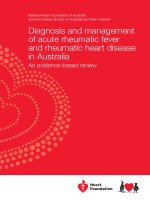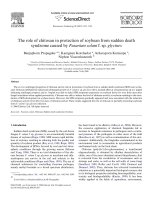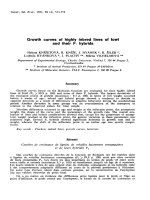Screening of maize inbred lines and popularly grown hybrids against banded leaf and sheath blight disease incited by Rhizoctonia solani f. sp. sasakii Exner
Bạn đang xem bản rút gọn của tài liệu. Xem và tải ngay bản đầy đủ của tài liệu tại đây (323.06 KB, 10 trang )
Int.J.Curr.Microbiol.App.Sci (2018) 7(11): 883-892
International Journal of Current Microbiology and Applied Sciences
ISSN: 2319-7706 Volume 7 Number 11 (2018)
Journal homepage:
Original Research Article
/>
Screening of Maize Inbred Lines and Popularly Grown Hybrids
against Banded Leaf and Sheath Blight Disease Incited by
Rhizoctonia solani f. sp. sasakii Exner
G. Bindu Madhavi1*, L.N. Hanuman1, G. Uma Devi2, K. Vijay Krishna Kumar3,
T. Ramesh Babu4 and T.C.M. Naidu5
1
Department of Plant Pathology, RARS, Lam, India
Department of Plant Pathology, College of Agriculture, PJTSAU, Hyd, India
3
Department of Agriculture, ANGRAU, India
4
RARS, Tirupathi, India
5
Regional Agricultural Research Station, Lam, Guntur, ANGRAU, Andhra Pradesh, India
2
*Corresponding author
ABSTRACT
Keywords
Maize, BLSB,
Rhizoctonia solani f. sp.
sasakii, Inbred lines,
Hybrid, Disease severity
Article Info
Accepted:
10 October 2018
Available Online:
10 November 2018
Banded Leaf and Sheath Blight (BLSB) disease caused by Rhizoctonia solani f. sp. sasakii
Exner was studied in 22 inbred lines and 12 hybrids at the Regional Agricultural Research
Station farm, Lam, Guntur, during rabi 2014-15 for evaluating resistance. Out of 22 inbred
lines, PFSR9-2 had shown resistant reaction whereas PFSR6-1, PFSR6-2 and PFSR18
were found to be moderately resistant to BLSB disease. In case of hybrids, DHM 117 is
the only hybrid which had shown resistant reaction, DKC9145, DKC9133 and KMH3110
were found moderately resistant and the remaining have shown susceptible reaction. The
laboratory and field evaluation data corresponded in actual disease rating as well as in
terms of categorization in to resistant, moderately resistant, susceptible and highly
susceptible.
Introduction
Maize (Zea mays L.) is the third most
important cereal crop after rice and wheat, in
the world agricultural economy as food for
humans and feed for livestock. About 112
diseases of maize have been reported so far
from different parts of the world. Of these, 65
are known to occur in India. The Banded Leaf
and Sheath Blight (BLSB) disease, caused by
Rhizoctonia solani f. sp. sasakii Exner
(teleomorph) Thanatephorus sasakii Shirai, is
considered as one of the most important
diseases of maize in South- and South-East
Asia (Sharma and Saxena, 2002), and has
potential ability to cause significant yield
reduction and loss in fodder quality (Sharma
et al., 2000).
In India, the disease is more prevalent during
kharif season and favours temperature of 2530°C and R.H.100% (Ahuja and Payak, 1981).
In India, the disease is more prevalent during
kharif season and favours temperature of 25-
883
Int.J.Curr.Microbiol.App.Sci (2018) 7(11): 883-892
30°C and R.H.100% (Ahuja and Payak,
1981).
It causes considerable amount (23.9 to 31.9%
or more) of crop yield loss at favourable
condition (Lal et al., 1980). Further, it is
estimated that 1% of total grain yield of India
is lost by the disease every year (Payak and
Sharma, 1985).
University in pipeline were screened for their
resistance against BLSB under artificial
epiphytotic condition during rabi 2014-15 in
field and lab conditions. Since the isolate
NSP-34 from Narsaraopet mandal of Guntur
district was found to be highly virulent in the
previous study, hence the same isolate was
used for screening hybrids and inbred lines
Screening under lab conditions
With the popularize and extensive planting of
compact hybrids, heavy use of nitrogen
fertilizer, the increase in planting density in
maize production facilitates the rapid spread
of BLSB, which caused a decreased
production of 10 to 20% or even higher
((Huang et al., 2007). Different approaches for
the management of BLSB have been
suggested, including mechanical control
through stripping of the two lower leaves
along with the leaf sheath (Sharma and
Hembram, 1990) and chemical control (Jiang
et al., 1991; Sharma and Rai, 1998). The
mechanical means of stripping the lower
leaves effectively checks the further spread of
the disease to the upper leaves and the ear, but
the method is labour-intensive, and is also not
cost- and time-effective. Similarly, chemical
control is expensive and less environment
friendly. Therefore, increasing emphasis is
currently being laid on host-plant resistance to
BLSB hence comprehensive efforts involving
a wider range of germ plasm and rigorous
evaluation at multiple locations are required.
With this background, the present study was
undertaken with an objective to analyze the
genetic variability in the maize inbred lines
and popularly grown hybrids for resistance to
BLSB at RARS, Lam, Guntur, Andhra
Pradesh
Materials and Methods
The popularly cultivated maize hybrids and
the inbred lines developed by Maize Research
Centre, Rajendranagar, PJSTS Agricultural
For laboratory testing, the leaves were
collected from 30 days old plants in the
afternoon for reasons given by Payak (1955).
Leaf pieces were cut in to suitable size
(8x5.5cm), washed in tap water and floated on
8 ml of 2ppm kinetin solution in petridishes.
Five replicates having one leaf piece in each
dish were maintained for all entries.
The leaf pieces were inoculated by placing
sclerotia on the midrib of adaxial surface and
incubated at 28+1 oC for 7 days. Observations
on disease development were recorded after 3
days and number of sclerotia developed was
counted after 7 days of inoculation on the
basis of the scale given by Ahuja and Payak,
1981.
Rating scale for banded leaf and sheath
blight
Screening under field conditions A total of 22
inbred lines and 12 hybrids of maize were
screened against BLSB under artificial
epiphytotic conditions in RARS, Lam field.
Each inbred line/hybrid was planted in a 5 m
long single row replicated twice in a
randomized block design. Inoculation was
made on 45 days old plants by toothpick
method High humidity (>90%) was
maintained
throughout
the
disease
development period by frequent irrigations.
Disease assessment was made at 35 days after
inoculation using 1-5 scale as described by
Ahuja and Payak (1978)
884
Int.J.Curr.Microbiol.App.Sci (2018) 7(11): 883-892
Rating scale
Disease is recoded after 30-35 days of
inoculations on basis of following rating scale.
Infection is on one leaf sheath, lesions are one
or few, non-coalescent
Infection is on two to three leaf sheaths,
lesions are few and non-coalescent on third
leaf sheath from ground level.
Infection is not up to the ear shoot but on more
than two leaf-sheaths
Infection is on all leaf sheaths up to the ear
shoot but shank is not infected. Infection
presents beyond the ear shoot; reduced ear
size, husk leaves bleached and caked with or
without sclerotial development; kernel
formation absent or rudimentary
Mass multiplication of R. solani inoculum:
Rice stem pieces (35-40 days old plants) were
cut in to pieces of about 2 cm size and filled in
to 2 kg polypropylene (PP) bags up to one
third. Ten ml (1%) peptone + sucrose (1:1)
solution was added in each PP bag and then
autoclaved at 15 pascals per square inch
(p.s.i_) for 30 minutes. Mycelial discs of 5mm
diameter of BLSB pathogen cut from the
margin of 3- days-old culture of the pathogen
were inoculated in to the PP bags and
incubated at 26+ 2 0 C for fifteen days. Inocula
multiplied on rice stem pieces were used for
inoculating the maize inbred lines and hybrids
for screening.
At least 10 plants in each replication for each
entry were scored and the disease scores were
used to estimate Disease Index (DI) for each
genotype, as suggested by Wang and Dai
(2001), as follows: DI = [L (severity class or
disease score x number of plants in this class)
/ the highest possible severity class or disease
score x total number of investigated plants] x
100. The responses of the genotypes were
rated using the 01 values, based on the
following scale: 0-30-resistant; >30- 60moderately resistant; >60-90-susceptible; and
>90-1 OO-highly susceptible.
Results and Discussion
The study was designed to identify new
sources of resistance to BLSB which can be
used in developing resistant cultivars to this
disease with a view to mitigate loss in
farmer’s fields.
The data of screening inbred lines and hybrids
under laboratory conditions was presented in
Table 1. The fungal growth from sclerotia
increased and spread with in 12 hr, infection
cushions appeared 1-2 cm away from the
inoculums point 18 hr after inoculation.
Initially these were hyaline but after 24hr they
turned brown and finally straw coloured spots
of 0.5- 0.8 mm diameter and became apparent.
The diameter of the spots increased after 48hr
of incubation. The lesions were surrounded by
water soaked greyish areas. The symptoms
expressed themselves in the form of small
spots to lesions covering most of the leaf
lamina. Number of sclerotia produced were
ranged from 4- 34 per plate. The inbred line
PFSR9-2 and hybrid DHM117 have shown
resistant reaction with average disease score 1
but developed on an average 9 and 7 sclerotia
per leaf bit in petridish. PFSR6-1, PFSR6-2
and PFSR18 were found to be moderately
resistant with disease score 2.4, 2.2 and 2.7
and no. of sclerotia 19, 14 and 8 respectively
(Plate 1).
The results of evaluation of hybrids and inbred
lines against BLSB under field conditions
were presented in Table 2 and it was found
that there were significant difference among
the lines and hybrids on disease incidence,
indicated the genetic variability for the trait
under study.
885
Int.J.Curr.Microbiol.App.Sci (2018) 7(11): 883-892
Table.1 Reaction of maize inbred lines and released hybrids to Banded Leaf and Sheath Blight
induced by R. solani f.sp. sasakii in laboratory
S. No.
Inbred lines/ Hybrid
1.
2.
3.
4.
5.
6.
7.
8.
9.
10.
11.
12.
13.
14.
15.
16.
17.
18.
19.
20.
21.
22.
23.
24.
25.
26.
27.
28.
29.
30.
31.
32.
33.
34.
PFSR-1
PFSR-6-1
PFSR 6-2
PFSR-9-2
PFSR13
PFSR-15
PFSR18
PFSR-25
PFSR-41
PFSR-10
BPT -7
BPT-10
BPT-19
BPT-20
BPT-22
BPT- 30
TR 5-1
TR-2
TR 30
TR-72
TR-74
TR-83
DHM-117
DHM-121
Pinnacle
DKC 9126
DKC 9145
DKC 9133
DKC 8101
KMH super 244
KMH 25K45
KMH 3110
Pioneer 30 V 92
Pioneer 3396
Sem
CD
Average
Disease grade
4.9
2.3
2.3
1.0
4.7
4.1
2.4
4.3
3.1
4.2
3.9
4.5
4.1
3.4
4.4
3.4
3.1
2.4
3.1
2.5
4.6
3.1
1.0
3.0
2.4
3.5
2.7
2.4
3.2
3.7
4.1
2.4
4.1
4.2
0.12
0.36
Average no. of
sclerotia
produced/leaf bit
18
19
14
9
34
9
8
25
11
24
7
15
6
15
25
22
12
19
23
27
10
4
7
20
19
14
10
5
17
11
21
8
10
15
PDI
97
45
46
20
94
82
48
85
62
83
78
89
81
68
87
68
62
48
62
49
91
62
20
59
48
69
54
47
63
73
82
48
82
83
Reaction
type*
HS
MR
MR
R
HS
HS
S
HS
S
HS
HS
HS
HS
HS
S
S
S
S
S
HS
S
R
S
HS
HS
S
MR
S
HS
HS
MR
HS
HS
1- Resistant (R); 1.1-2.5 Moderately resistant (M R) 2.6-3.5- Susceptible (S), 3.6-5.0 -Highly Susceptible (H S)
886
Int.J.Curr.Microbiol.App.Sci (2018) 7(11): 883-892
Table.2 Reaction of maize inbred lines and released hybrids to Banded Leaf and Sheath Blight
induced by R. solani f. sp. sasakii under artificial inoculation conditions in field
S. No.
1.
2.
3.
4.
5.
6.
7.
8.
9.
10.
11.
12.
13.
14.
15.
16.
17.
18.
19.
20.
21.
22.
23.
24.
25.
26.
27.
28.
29.
30.
31.
32.
33.
34.
Inbred lines/
Hybrid
PFSR-1
PFSR-6-1
PFSR 6-2
PFSR-9-2
PFSR13
PFSR-15
PFSR18
PFSR-25
PFSR-41
PFSR-10
BPT -7
BPT-10
BPT-19
BPT-20
BPT-22
BPT- 30
TR 5-1
TR-2
TR 30
TR-72
TR-74
TR-83
DHM-117
DHM-121
Pinnacle
DKC 9126
DKC 9145
DKC 9133
DKC 8101
KMH super 244
KMH 25K45
KMH 3110
Pioneer 30 V 92
Pioneer 3396
Sem
CD
Average Disease
grade
PDI
Reaction type*
4.1
2.4
2.2
1.0
4.6
4.6
2.7
4.1
3.1
4.5
3.9
4.2
4.0
3.6
4.1
3.8
3.0
2.6
3.1
2.9
4.3
2.9
1.0
3.1
4.0
3.6
2.8
2.2
3.6
3.8
4.3
2.4
4.1
4.5
0.09
0.28
82
48
44
20
91
92
54
82
61
89
78
84
80
71
82
75
59
52
62
58
86
58
20
61
80
72
55
43
71
76
86
47
81
89
HS
MR
MR
R
HS
HS
S
HS
S
HS
HS
HS
HS
HS
HS
S
MR
MR
S
MR
HS
S
R
S
MR
MR
S
MR
S
S
HS
MR
HS
HS
1- Resistant (R); 1.1-2.5 Moderately resistant (M R) 2.6-3.5- Susceptible (S), 3.6-5.0 -Highly Susceptible (H S)
887
Int.J.Curr.Microbiol.App.Sci (2018) 7(11): 883-892
888
Int.J.Curr.Microbiol.App.Sci (2018) 7(11): 883-892
Screening under lab conditions
Disease Score Reaction
1
1.1-2.5
2.6- 3.5
3.6-5.0
Resistant (R)
Moderately resistant (M R)
Susceptible (S)
Highly Susceptible (H S)
889
Int.J.Curr.Microbiol.App.Sci (2018) 7(11): 883-892
The genotypes most severely infected
generally had severe symptoms on the lower
leaves, but more importantly, they had the
most rapid development of systemic infection
on the upper leaves, including the husk (Plate
2 & 3)
cyclic breeding scheme to meet the immediate
challenges posed by BLSB.
The observations on differential responses of
the maize lines to BLSB disease are in
congruence with observations from different
researchers.Among the 29 inbreeds of maize
analyzed,
only
a
single
genotype
CA00106,recorded moderate resistance to
BLSB at all the three locations and the
remaining were found highly susceptible
(Anshu et al., 2007). The pooled data of three
years (2003 -2005) revealed that the
genotypes, DRLT-180 IC324207, G-RS-7,
RKU-193 IC309233and MZ-80 IC339731 of
National Bureau of Plant Genetic Resource
Station, Shillong were resistant (with disease
rating 10. to 2.0), while, RS-9 and RKU-113
IC309153 were susceptible (4.1 to 5.0) and
the rest others were intermediate (2.1 to 4.0)
in disease reaction of BLSB (Biswas et al.,
2007).
The per cent disease index calculated thirty
days after inoculation in field trial revealed
that PFSR-1 recorded highest PDI 97 with the
average disease score 4.9. All the inbred lines
and the hybrids showed variation with regard
to Percent Disease Index and ranged from 2097 PDI. Out of the 12 hybrids screened for
disease resistance, it was found that DHM117 was resistant and the remaining all
hybrids were more or less affected by the
disease. However, the hybrids DKC 9145,
DKC 9133 and KMH 3110 were found
moderately resistant with disease scores 2.7,
2.4 and 2.4 respectively.
In case of inbred lines, PFSR-9-2 had shown
resistant reaction with PDI 20 whereas the
PFSR-6-1 and PFSR6-2 were found
moderately resistant with PDI 45 and 46
respectively. Among 22 inbred lines 10 lines
had shown highly susceptible reaction
whereas 8 were found to be susceptible to
BLSB. The laboratory and field evaluation
data corresponded in actual disease rating as
well as in terms of categorization in to
resistant, MR, S and HS.
Maize inbred lines, CA003134, CA00396 and
CA00310 (CML 465) showing intermediate
reaction were also found to have higher
degree of tolerance against BLSB than other
lines. Similarly, it has also been found that
inbred lines CA14510 (CML 428), CA14524
(CML 474) and Suwan 1 (S) C# f-f possessed
high degree of tolerance to BLSB (Sharma et
al., 2005).
The laboratory method used was proved
useful for screening of maize germplasm to
BLSB. It can be helpful in rapid identification
and elimination of susceptible to highly
susceptible cultivars. In addition the use of
excised leaf pieces allows precise control of
incubation, temperature and humidity
conditions. This method is also advantageous
because of ease in operation, handling and
observation. Moreover it requires lesser
amount of test material. The method was
successfully used to study host range (Ahuja,
1976) and relationship of temperature and
Germplasm evaluation was extensively
carried out in the past using a large number of
maize varieties, hybrids and inbred lines to
find our resistance source to BLSB but the
success in achieving the absolute resistance
seems to be impracticable. At present narrow
genetic base for resistance to BLSB has been
found to be a bottleneck for an effective
resistance breeding programme. However, the
lines reported in this study as promising can
be utilized as such or their resistance can be
transferred into commercial varieties using
890
Int.J.Curr.Microbiol.App.Sci (2018) 7(11): 883-892
relative humidity with the development of
BLSB (Ahuja and Payak, 1981)
maize. Southwest China J. Agric. Sci.
20(2):209-21.
Jiang, H.L., Ding, X. and Ma, H. (1991). The
occurrence and chemical control of
maize sheath blight (Rhizoctonia solani)
in Rugao of Jiangsu. PlantProtection 6:
11-12.
Lal, S., Baruah, P. and Butchaiah, K. (1980).
Assessment of yield losses in maize
cultivars due to banded sclerotial
disease. Indian Phytopath. 33: 440-443.
Payak, M.M. (1955). A modified petri dish
method for rust infection on excised
leaves. Experientia 21:239-241
Payak, M.M. and Sharma, R.C. (1985). Maize
diseases and approaches to their
management in India. Trop. Pest Mgmt.
31: 302-310.
Puzari, K.C., Saikia, U.N., Bhattacharyya, A.
and
Bhattacharyya,
A.
(1998).
Management of banded leaf and sheath
blight of maize with chemicals. Indian
Phytopath. 51: 78-80.
Sharma, G. and Saxena, S.C. (2002).
Integrated management of banded leaf
and sheath blight of maize (Zea mays
L.) caused by Rhizoctonia solani Kuhn.
Adv. Plant Sci. 15: 107-113.
Sharma, R.C. and Hembram, D. (1990). Leaf
stripping - a new method to control
banded leaf and sheath blight of maize.
Curr Sci. 59: 745-746.
Sharma, R.C. and Rai, S.N. (1998). Chemical
control of banded leaf and sheath blight
of maize. Indian Phytopath. 52: 94-95.
Sharma, R.C., De Leon, C. and Singh, N.N.
(2000). Banded leaf and sheath blight of
maize – Its importance and current
breeding efforts. In: Proc. T" Asian
Regional Maize Workshop, PCARRD,
Los Banos, Philippines (Eds. Vasal,
S.K., Gonzalez-Ceniceros, F. and XingMing, F.), CIMMYT, Mexico, pp. 284289.
Sharma, R.C., Rai, S.N. and Batsa, B.K.
(2005). Identifying resistance to banded
Acknowledgements
We
thank
AICRP
Maize
centre,
Rajendranagar, PJTSAU, Hyderabad for
providing the seed material of the inbred lines
and hybrid used in this study. Our thanks are
Associate Director of Research, RARS, Lam,
Guntur, Andhra Pradesh for their kind support
in field experimentation. The study was
undertaken as a part of the doctoral research
of the first author.
References
Ahuja, S.C. (1976). Investigations on banded
leaf & sheath blight of maize. Ph.D.
Thesis, IARI, New Delhi.
Ahuja, S.C. and Payak, M.M. (1978). A field
inoculation technique for evaluating
maize germ plasm to banded leaf and
sheath blight. Indian Phytopath. 31:
517-520.
Ahuja, S.C. and Payak, M.M. (1981).
Relationship of relative humidity and
temperature
levels
with
the
development of banded leaf and sheath
blight of maize. Zeits. fur Pflanzen. und
Pflanzenschutz,88: 265-268.
Ahuja, S.C. and Payak, M.M. (1983). A rating
scale for banded leaf and sheath blight
of maize. Indian Phytopath. 36: 338340.
Anshu Garg, B.M., Prasannn, R.C., Sharmn,
R.S., Rathore, S.C., Saxena and S.V.S.
Chauhan. (2007). Identification of
resistance sources to banded leaf and
sheath blight (Rhizoctonia solani f. sp.
sasakil) in maize. Indian Phytopath. 60
(2): 162-166
Huang, M.B., Tang. J, Yang, J.P. and Yang,
K.C. (2007). Research advance on
Banded Leaf and Sheath Blight of
891
Int.J.Curr.Microbiol.App.Sci (2018) 7(11): 883-892
leaf and sheath blight of maize. Indian
Phytopath. 58: 121-122.
Subrata Biswas, K. Chattopadhyay and Singh,
N.P. 2007. Evaluation against sheath
blight disease of maize under natural
conditions Indian Phytopath. 60 (3):
302-305
Wang, X.M. and Dai, F.C. (2001). The Field
Manual of Plant Diseases and Insect
Pests of Maize. Press of Agricultural
Science and Technology, China, pp. 92.
How to cite this article:
Bindu Madhavi, G., L.N. Hanuman, G. Uma Devi, K. Vijay Krishna Kumar, T. Ramesh Babu
and Naidu, T.C.M. 2018. Screening of Maize Inbred Lines and Popularly Grown Hybrids
against Banded Leaf and Sheath Blight Disease Incited by Rhizoctonia solani f. sp. sasakii
Exner. Int.J.Curr.Microbiol.App.Sci. 7(11): 883-892.
doi: />
892









